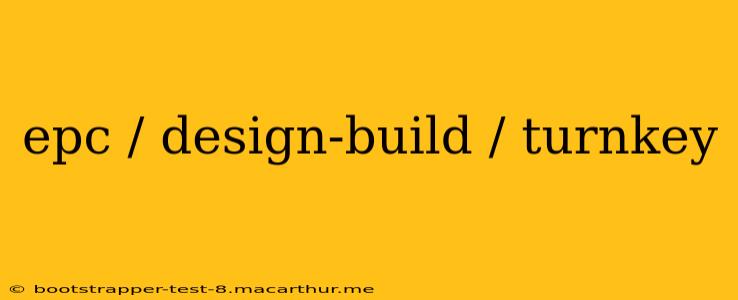The engineering, procurement, and construction (EPC), design-build, and turnkey project delivery methods are popular choices for complex projects, but understanding their nuances is crucial for successful project execution. This article clarifies the differences between these methods, highlighting their benefits and when each approach is most suitable.
What is EPC (Engineering, Procurement, and Construction)?
EPC is a project delivery method where a single contractor (the EPC contractor) takes responsibility for the entire project lifecycle, from engineering and design to procurement of materials and construction. This streamlined approach offers several advantages:
- Single Point of Contact: This simplifies communication and accountability, reducing potential conflicts between different contractors.
- Faster Project Completion: The integrated approach allows for parallel work streams, potentially speeding up the overall project timeline.
- Cost Efficiency: Streamlined processes and optimized procurement can contribute to cost savings.
- Reduced Risk: The EPC contractor assumes responsibility for risks associated with design, procurement, and construction.
What is Design-Build?
Design-build merges the design and construction phases under a single contract. While similar to EPC, the key difference lies in the level of responsibility. In design-build, the design is often developed collaboratively between the owner and the contractor, whereas in EPC, the contractor typically takes the lead on design based on the owner's requirements. Design-build projects often benefit from:
- Improved Communication & Collaboration: Close collaboration between designers and constructors from the outset can lead to more efficient and innovative solutions.
- Faster Project Delivery: Overlapping design and construction phases can accelerate project timelines.
- Simplified Project Management: A single point of contact simplifies communication and coordination.
- Reduced Cost Overruns: Integrated design and construction processes can help minimize errors and rework.
What is Turnkey?
Turnkey projects deliver a fully functional facility or system ready for immediate operation. The contractor handles everything from initial concept to final handover, leaving the client with a "turnkey" solution—ready to operate without further involvement. Key characteristics of turnkey projects include:
- Complete Project Responsibility: The contractor manages all aspects, including design, engineering, procurement, construction, commissioning, and even training.
- Simplified Client Involvement: The client's involvement is minimal, focusing on providing initial requirements and reviewing milestones.
- Reduced Risk for Client: The contractor bears the majority of project risks.
- Predictable Costs and Timelines: A clearly defined scope and single contract help ensure predictable outcomes.
What are the Key Differences Between EPC, Design-Build, and Turnkey?
While overlapping, key distinctions exist:
| Feature | EPC | Design-Build | Turnkey |
|---|---|---|---|
| Design | Contractor-led, based on client specs | Collaborative, often owner-involved | Contractor-led, fully encompassing |
| Procurement | Contractor manages | Contractor manages | Contractor manages |
| Construction | Contractor manages | Contractor manages | Contractor manages |
| Commissioning | Often included | Often included | Always included, along with training |
| Client Role | Provides requirements, oversees | Greater involvement in design process | Minimal involvement, primarily oversight |
Which Method is Right for My Project?
The best project delivery method depends on several factors, including:
- Project Complexity: Highly complex projects may benefit from the integrated approach of EPC or Turnkey.
- Client Expertise: Clients with limited in-house expertise might prefer a turnkey approach.
- Budget: The cost implications of each method must be carefully evaluated.
- Time Constraints: EPC and Design-Build often offer faster project completion times.
- Risk Tolerance: Turnkey projects transfer most risks to the contractor.
Careful consideration of these factors will help you select the most suitable approach for your specific needs. Consulting with experienced project managers is highly recommended.
What are the Benefits of Using an EPC Contractor?
As discussed above, using an EPC contractor offers a single point of contact, potentially faster project completion, cost efficiencies, and reduced risk. This streamlined approach simplifies project management and accountability.
What are the Advantages of a Design-Build Approach?
Design-build’s advantages include improved communication and collaboration, faster project delivery, simplified project management, and reduced cost overruns due to the integrated design and construction phases.
What are the Disadvantages of Turnkey Projects?
While offering a "ready-to-go" solution, turnkey projects might lack client input during the design phase, and the initial fixed cost may not accommodate unforeseen changes or circumstances. Transparency in the project process is also crucial.
This comprehensive overview aims to clarify the distinctions and benefits of EPC, design-build, and turnkey project delivery methods. Remember, selecting the appropriate method is critical for a successful project outcome.
